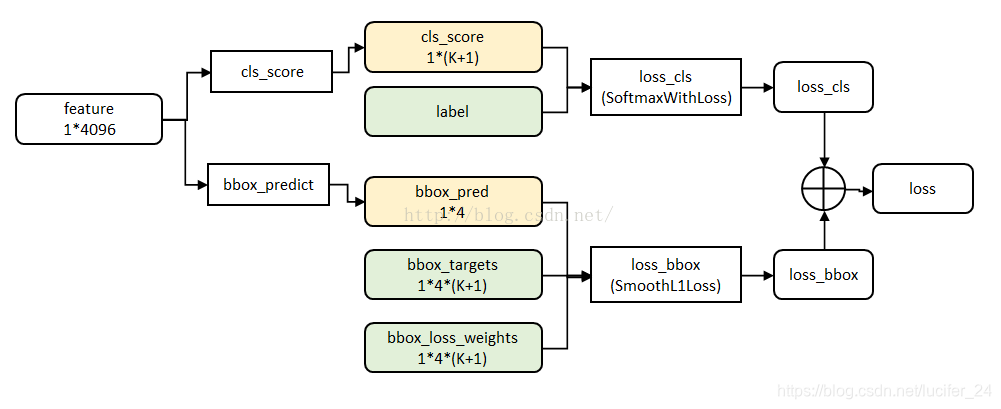Faster RCNN是个很经典的two-stage目标检测网络,也是一年多以前我接触到的第一个深度学习网络。现在结合着github上大神复现的pytorch源码认真研读一下。博客仅做自己的理解和笔记。
参考文章:https://zhuanlan.zhihu.com/p/31426458 ,这篇是我看过的最好的介绍Faster RCNN的文章。
github代码地址:https://github.com/jwyang/faster-rcnn.pytorch ,框架用的是pytorch
RPN的结构

可以看到RPN网络实际分为2条线,上面一条通过softmax分类anchors获得foreground和background(检测目标是foreground),下面一条用于计算对于anchors的bounding box regression偏移量,以获得精确的proposal。而最后的Proposal层则负责综合foreground anchors和bounding box regression偏移量获取proposals,同时剔除太小和超出边界的proposals。其实整个网络到了Proposal Layer这里,就完成了相当于目标定位的功能。
也可以参考caffe网络结构生成的图

在代码中lib/rpn文件夹的目录结构是这样的

# for each (H, W) location i
# generate A anchor boxes centered on cell i
# apply predicted bbox deltas at cell i to each of the A anchors
# clip predicted boxes to image
# remove predicted boxes with either height or width < threshold
# sort all (proposal, score) pairs by score from highest to lowest
# take top pre_nms_topN proposals before NMS
# apply NMS with threshold 0.7 to remaining proposals
# take after_nms_topN proposals after NMS
# return the top proposals (-> RoIs top, scores top)
- generate_anchors.py 在 proposal _layer.py 中被调用,用来对每个像素点生成4*9的向量(9个anchor,每个anchor输出x,y,w,h四个坐标)
- anchor_target_layer 对每个anchor生成类别标签和bbox Regression targets,返回 rpn.py 中中计算loss
RPN流程
一副MxN大小的矩阵送入Faster RCNN网络后,到RPN网络变为(M/16)x(N/16),不妨设 W=M/16,H=N/16。
首先经过3x3卷积,通道数为512,变为512xWxH
然后分为两条路,经过两个1x1卷积,通道数分别变为18和36
卷积核定义如下:
# define the convrelu layers processing input feature map
self.RPN_Conv = nn.Conv2d(self.din, 512, 3, 1, 1, bias=True) # input size = output size
# define bg/fg classifcation score layer
self.nc_score_out = len(self.anchor_scales) * len(self.anchor_ratios) * 2 # 2(bg/fg) * 9 (anchors)
self.RPN_cls_score = nn.Conv2d(512, self.nc_score_out, 1, 1, 0)
# define anchor box offset prediction layer
self.nc_bbox_out = len(self.anchor_scales) * len(self.anchor_ratios) * 4 # 4(coords) * 9 (anchors)
self.RPN_bbox_pred = nn.Conv2d(512, self.nc_bbox_out, 1, 1, 0)
# define proposal layer
self.RPN_proposal = _ProposalLayer(self.feat_stride, self.anchor_scales, self.anchor_ratios)
# define anchor target layer
self.RPN_anchor_target = _AnchorTargetLayer(self.feat_stride, self.anchor_scales, self.anchor_ratios)
rpn.py的forward()函数如下:
batch_size = base_feat.size(0)
# return feature map after convrelu layer
rpn_conv1 = F.relu(self.RPN_Conv(base_feat), inplace=True) # (1, 512, H, W)
# get rpn classification score
rpn_cls_score = self.RPN_cls_score(rpn_conv1) # (1, 2*9, H, W)
rpn_cls_score_reshape = self.reshape(rpn_cls_score, 2) # (1, 2*9, H, W)->(1, 2, 9*H, W)
rpn_cls_prob_reshape = F.softmax(rpn_cls_score_reshape, 1)
rpn_cls_prob = self.reshape(rpn_cls_prob_reshape, self.nc_score_out) # (1, 2, 9*H, W)->(1, 2*9, H, W)
# get rpn offsets to the anchor boxes
rpn_bbox_pred = self.RPN_bbox_pred(rpn_conv1) # (1, 512, H, W)->(1, 4*9, H, W)
# proposal layer
cfg_key = 'TRAIN' if self.training else 'TEST'
rois = self.RPN_proposal((rpn_cls_prob.data, rpn_bbox_pred.data,
im_info, cfg_key))
self.rpn_loss_cls = 0
self.rpn_loss_box = 0
# generating training labels and build the rpn loss
if self.training:
assert gt_boxes is not None
rpn_data = self.RPN_anchor_target((rpn_cls_score.data, gt_boxes, im_info, num_boxes))
# compute classification loss
rpn_cls_score = rpn_cls_score_reshape.permute(0, 2, 3, 1).contiguous().view(batch_size, -1, 2)
rpn_label = rpn_data[0].view(batch_size, -1)
rpn_keep = Variable(rpn_label.view(-1).ne(-1).nonzero().view(-1))
rpn_cls_score = torch.index_select(rpn_cls_score.view(-1,2), 0, rpn_keep)
rpn_label = torch.index_select(rpn_label.view(-1), 0, rpn_keep.data)
rpn_label = Variable(rpn_label.long())
self.rpn_loss_cls = F.cross_entropy(rpn_cls_score, rpn_label)
fg_cnt = torch.sum(rpn_label.data.ne(0))
rpn_bbox_targets, rpn_bbox_inside_weights, rpn_bbox_outside_weights = rpn_data[1:]
# compute bbox regression loss
rpn_bbox_inside_weights = Variable(rpn_bbox_inside_weights)
rpn_bbox_outside_weights = Variable(rpn_bbox_outside_weights)
rpn_bbox_targets = Variable(rpn_bbox_targets)
self.rpn_loss_box = _smooth_l1_loss(rpn_bbox_pred, rpn_bbox_targets, rpn_bbox_inside_weights,
rpn_bbox_outside_weights, sigma=3, dim=[1,2,3])
return rois, self.rpn_loss_cls, self.rpn_loss_box
rpn_cls_score是保存bg/fg anchors的矩阵,存储形式为[1, 2x9, H, W]。而在softmax分类时需要进行fg/bg二分类,所以reshape layer会将其变为[1, 2, 9xH, W]大小,即单独“腾空”出来一个维度以便softmax分类,之后再reshape回复原状。
生成anchor
rois = self.RPN_proposal((rpn_cls_prob.data, rpn_bbox_pred.data, im_info, cfg_key))
RPN_proposal调用init里面的_ProposalLayer类生成合适的anchor。
self.RPN_proposal = _ProposalLayer(self.feat_stride, self.anchor_scales, self.anchor_ratios)
首先调用generate_anchors函数。所谓anchors,实际上就是一组由rpn/generate_anchors.py生成的矩形。直接运行作者demo中的generate_anchors.py可以得到以下输出:
[[ -84. -40. 99. 55.]
[-176. -88. 191. 103.]
[-360. -184. 375. 199.]
[ -56. -56. 71. 71.]
[-120. -120. 135. 135.]
[-248. -248. 263. 263.]
[ -36. -80. 51. 95.]
[ -80. -168. 95. 183.]
[-168. -344. 183. 359.]]
其中每行的4个值 (x_1, y_1, x_2, y_2) 表矩形左上和右下角点坐标。9个矩形共有3种形状,长宽比为大约为 {1:1, 1:2, 2:1} 三种。

_ProposalLayer()做了以下几件事情:
- 生成anchors,所有的anchors做bbox regression回归(这里的anchors生成和训练时完全一致)
- 按照输入的foreground softmax scores由大到小排序anchors,提取前pre_nms_topN(e.g. 12000)个anchors,即提取修正位置后的foreground anchors。
- 限定超出图像边界的foreground anchors为图像边界(防止后续roi pooling时proposal超出图像边界)
- 剔除非常小(width<threshold or height<threshold)的foreground anchors
- 进行nonmaximum suppression(NMS非极大值抑制)
- 再次按照nms后的foreground softmax scores由大到小排序fg anchors,提取前post_nms_topN(e.g. 2000)结果作为proposal输出。
损失函数


具体每个变量的意义还是看论文,写得很清楚。Ncls=256,Nreg~=2000,λ=10。
分类使用softmax回归,使用的是交叉熵损失函数,公式:

代码:
rpn_data = self.RPN_anchor_target((rpn_cls_score.data, gt_boxes, im_info, num_boxes))
# compute classification loss
rpn_cls_score = rpn_cls_score_reshape.permute(0, 2, 3, 1).contiguous().view(batch_size, -1, 2)
rpn_label = rpn_data[0].view(batch_size, -1)
rpn_keep = Variable(rpn_label.view(-1).ne(-1).nonzero().view(-1))
rpn_cls_score = torch.index_select(rpn_cls_score.view(-1,2), 0, rpn_keep)
rpn_label = torch.index_select(rpn_label.view(-1), 0, rpn_keep.data)
rpn_label = Variable(rpn_label.long())
self.rpn_loss_cls = F.cross_entropy(rpn_cls_score, rpn_label)
fg_cnt = torch.sum(rpn_label.data.ne(0))
边界框的线性回归损失函数。线性回归就是给定输入的特征向量X, 学习一组参数W, 使得经过线性回归后的值跟真实值Y(即GT)非常接近,即Y=WX。对于该问题,输入X是一张经过卷积获得的feature map,定义为Φ;同时还有训练传入的GT。

这里R用smooth L1损失函数。Lerg前面乘一个p*,说明只有正样本,即forground anchor对损失函数有贡献,bg anchor贡献为0。smooth L1是一个平滑的绝对值函数,公式如下:

只有在GT与需要回归框位置比较接近时,可以认为是线性变换。论文里是这么写的:
where x, y, w, and h denote the box’s center coordinates and its width and height. Variables x, xa, and
x∗ are for the predicted box, anchor box, and groundtruth box respectively (likewise for y, w, h).

代码如下:
# compute bbox regression loss
rpn_bbox_inside_weights = Variable(rpn_bbox_inside_weights)
rpn_bbox_outside_weights = Variable(rpn_bbox_outside_weights)
rpn_bbox_targets = Variable(rpn_bbox_targets)
self.rpn_loss_box = _smooth_l1_loss(rpn_bbox_pred, rpn_bbox_targets, rpn_bbox_inside_weights,
rpn_bbox_outside_weights, sigma=3, dim=[1,2,3])





 本文结合pytorch源码研读经典的two - stage目标检测网络Faster RCNN中的RPN网络。介绍了RPN的结构,包括分类和回归两条线及Proposal层;阐述了RPN流程,如矩阵输入后的卷积变化;说明了anchor的生成过程和筛选步骤;还提及了分类和边界框回归的损失函数。
本文结合pytorch源码研读经典的two - stage目标检测网络Faster RCNN中的RPN网络。介绍了RPN的结构,包括分类和回归两条线及Proposal层;阐述了RPN流程,如矩阵输入后的卷积变化;说明了anchor的生成过程和筛选步骤;还提及了分类和边界框回归的损失函数。

















 6603
6603

 被折叠的 条评论
为什么被折叠?
被折叠的 条评论
为什么被折叠?








